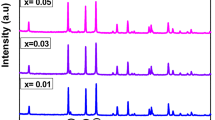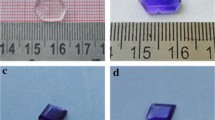Abstract
Polycrystalline LnTiTaO6 (Ln = Ce, Pr, Sm) compounds were prepared in the solid state ceramic route. The powders were calcined between 1250 °C and 1300 °C and sintered between 1480 °C and 1520 °C. The materials were characterized by XRD and SEM. The dielectric properties were measured in the frequency range 1 kHz–5 MHz. The absorption spectra and photoluminescence spectra of the samples were analysed. The materials are useful as gain media in micro lasers because of the optical absorption and photoluminescence.
Similar content being viewed by others
Avoid common mistakes on your manuscript.
1 Introduction
Inorganic luminescent crystalline materials that absorb energy and subsequently emit the absorbed energy as light are currently gaining wide spread interest due to the rapid developments in the field of optoelectronic devices. Materials with good concentration of lanthanides have importance as they can be used as an ideal gain media in laser diode pumped micro lasers. It is better to use intrinsic concentrations of rare earths on ceramic systems than doping since doping may cause lattice mismatch due to difference in the ionic radii, charge and dopant segregation effects [1, 2]. Wachtel et al. [3] reported Mg4Nb2O9 as a good luminescent material having self activated photoluminescence at room temperature and You et al. [4] reported that its luminescent properties can be enhanced by doping it with Cerium. A lot of materials have been reported having luminescent properties using various dopants.
The single phase occurrence of a special group of materials with general formula A3+B4+C5+O6 was reported for the first time by Kazantsev et al. [5]. They reported the optimum conditions for the formation of LnTiTaO6 polycrystals. The rare earth titanium tantalum compounds with rare earth atomic number in the range 57–66 have an orthorhombic aeschynite structure and compounds with rare earth atomic number of 67–71 have an orthorhombic euxenite structure. Later Holcombe studied the crystal structure of AlTiTaO6 and YTiTaO6 [6, 7]. In 1987 Maeda et al. suggested the possibility of using rare earth titanium tantalates and niobates for microwave frequency applications [8]. Sebastian et al. reported the possibility of using SmTiNbO6 ceramics as good dielectric Resonators [9]. Qi et al reported the preparation of RETiNbO6 (RE = Nd, Pr, Er) single crystals by Laser Heated Pedestal Growth and RETiNbO6 (RE = Nd, Pr) by the modified Czochralski growth method [10, 11]. Optical Spectroscopic studies of LnTiNbO6 (Ln = Pr, Nd and Er) were reported by Qi et al. [12]. They suggested that the materials are of potential applications as gain media in micro lasers due to the intense optical absorption and luminescence which is due to the high concentrations of lanthanide ions in the crystal and the odd parity distortions which enhances the transitions. Later the dielectric resonator properties of lanthanide titanium tantalates were reported by Surendran et al. [13]. EuTiNbO6, EuTiTaO6 and Y0.5Eu0.5TiNbO6 were reported as good scintillators for gamma ray and neutron registration [14]. In this paper we report the photoluminescence and low frequency dielectric behavior of poly crystalline CeTiTaO6 (CTT), PrTiTaO6 (PTT) and SmTiTaO6 (STT) ceramics for the first time.
2 Experimental
The LnTiTaO6 (Ln = Ce, Pr and Sm) compounds have been synthesized through the conventional solid state ceramic route. The oxides CeO2, Pr6O11, Sm2O3, TiO2 and Ta2O5 with purity >99.9% were used. The stochiometric mixtures of oxides were mixed in an agate mortar in distilled water medium and dried. The powder was then calcined in the range1250–1300 °C for 5 h in air. The calcined powder was ground well and mixed with PVA (4 wt%) as the binder and dried again. This was again ground to fine powder and shaped into cylindrical compacts of about 11 mm diameter and 2 mm thickness with a pressure of about 100 MPa. The samples were sintered between 1480 °C and 1520 °C for 5 h in air.
The bulk densities of the samples were measured by the Archimedes method. The phase purity and structure were studied by X-ray diffraction (XRD) using Cu-Kα radiation (Philips Expert Pro).
For low frequency dielectric studies the pellets were made in the form of a disc capacitor with the specimen as the dielectric medium. The capacitance and conductance of the samples were measured using an LCR meter (Hioki-3532-50) with in the frequency range 1 kHz–5 MHz. The samples were thermally etched 50 °C below the sintering temperature and microstructure was recorded using scanning electron microscopy (SEM) (Hitachi-S2400).
The photoluminescence spectra of the samples were measured using Flurolog®-3 Spectroflurometer. The photons from the source were filtered by an excitation spectrometer. The monochromatic radiation was then allowed to fall on the disc samples and the resulting radiation was filtered by an emission spectrometer and then fed to a photomultiplier detector. The variation of intensity was recorded as a function of wavelength. The absorption spectra were also measured using a Jasco UV-Visible spectrophotometer
3 Results and discussion
The XRD patterns of LnTiTaO6 (Ln = Ce, Pr and Sm) compounds are shown in Fig. 1. These materials crystallize in the aeschynite orthorhombic structure as reported in one of our earlier communications [13].
The cell volume, theoretical density and dielectric properties are given in Table 1.
The variation of dielectric constant of the samples with respect to frequency is shown in Fig. 2. The dielectric constant gradually decreases with increase in frequency and finally reaches almost a constant value for CTT. But for PTT and STT the dielectric constant shows no significant variation. The conductance is very small at low frequencies which is of the order of 10−7 Ω−1 for CTT and 10−9 Ω−1 for PTT and STT. The variation of conductance with increase in frequency is shown in Fig. 3.The conductance reaches of the order of about 10−6 Ω−1 above 1 MHz.
The microstructures of the samples are given in Fig. 4. These pictures show uniform distribution of grains of size 2–4 μm. The packing density, uniformity and homogeneity of particles are more for CTT than others. The low conductivity observed for PTT and STT compared to CTT may be due to considerable grain boundary scattering arising from the roughness seen on the morphology of the samples. Grain boundary scattering is dominant in polycrystals.
The absorption spectra of the samples in the wavelength region 225–820 nm are shown in Fig. 5. For CTT there is no considerable absorption in this region. For PTT there is a strong absorption band around 600 nm. There are absorption bands between 400 nm and 500 nm. The STT sample has strong absorption between 300 nm and 500 nm.
The photoluminescence spectra obtained at the excitation wavelength 400 nm of the samples are given in Fig. 6. The strong line of CTT at 695.3 nm is due to the transition \( {}^3G_3^0 - {}^0A_3 \) of cerium. The weaker lines at about 549.8 nm and 662.2 nm are due to the transitions \( {}^1D_1^0 - {}^0A_1 \) and \( ^3 H_6 ^0 - ^0 A_6 \) respectively. For PTT the lines at about 661.6, 500.5 and 548.9 nm are due to the transitions \( ^4 I_{9/2} ^0 - ^0 A_{11/2} \), \( ^6 L_{13/2} - ^0 A_{11/2} ^0 \) and \( ^6 L_{13/2} - ^0 A_{13/2} ^0 \) respectively of praseodymium. For STT the strong line at about 695.2 nm is due to the \( ^7 F_5 - ^7 G_4 ^0 \) transition of samarium. The other two lines at about 548.5 nm and 659.4 nm are due to \( ^7 F_0 - ^0 A_1 ^0 \) and \( {}^9D_5 - {}^7D_4^0 \) respectively.
4 Conclusion
The LnTiTaO6 (Ln = Ce, Pr, Sm) were prepared in the solid state ceramic route. The powders were calcined between 1250 °C and 1300 °C and sintered between 1480 °C and 1520 °C. The materials were characterized by XRD and SEM. The dielectric properties were measured in the frequency range 1 kHz- 5 MHz. The photoluminescence and absorption spectra were analyzed. The materials are useful as gain media in micro lasers because of the optical absorption and photoluminescence. Work is in progress by substituting other lanthanide elements. The optical properties can be improved by doping with suitable materials.
References
M.J. Weber, (ed) Lasers and Masers (Hand book of Laser science and technology 1) (Chemical Rubber Company Press, Boca Ratom, FL, 1982)
A.A Kaminskii, Laser Crystals 2nd edn. (Springer, Berlin, 1990)
A. Wachtel, J. Electrochem. Soc 111, 534 (1964)
Y.C. You, N. Park, K.H. Jung, H.L. Park, K.C. Kim, S.I. Mho, T.W. Kim, J. Mater. Sci. Lett. 13, 1682 (1994)
V. Vkazantsev, E.I. Krylov, A.K. Borisov, A.I. Chupin, Russian. J. Inorg. Chem. 19, 506 (1974)
C.E. Holcombe, J. Mater. Sci. Lett. 14, 2255 (1974)
C.E. Holcombe, M.K. Morrow, D.D Smith, D.A. Carpenter, Survey study of low expanding, high melting, Mixed Oxides, Y-1913 (Union Carbide Corporation,Nuclear Division, Oak Ridge, TN, 1974
M. Maeda, T. Yamamura, T. Ikeda, Jpn. J. Appl. Phys. 26, 76 (1987)
M.T. Sebastiam, S. Solomon, R. Ratheesh, J. George, P. Mohanan, J. Am. Ceram. Soc. 84, 1487 (2001)
X. Qi, R. Illingworth, H.G. Gallagher, T.P.J. Han, B. Henderson, J. Cryst. Growth 160, 111 (1996)
X. Qi, H.G. Gallagher, T.P.J. Han, B. Henderson, J. Cryst. Growth 180, 73 (1997)
X. Qi, T.P.J. Han, H.G. Gallagher, B. Henderson, R. Illingworth, I.S. Ruddock, J. Phys. Condens. Matter 8, 483 (1996)
K.P. Surendran, S. Solomon, M.R. Varma, P. Mohanan, M.T. Sebastian, J. Mater. Res. 17, 2561 (2002)
T.S. Koroleva, B.V. Shulgin, Ch. Pedrini, V.Yu. Ivanov, D.V. Raikov, A.N. Tcherepanov, Nucl. Instrum. Methods 537, 415 (2005)
Acknowledgements
The authors are grateful to Dr. M.T. Sebastian for his support in doing this work. Authors Sam Solomon and H. Padma Kumar are thankful for Kerala State council for Science, Technology and Environment (KSCSTE) for financial assistance.
Author information
Authors and Affiliations
Corresponding author
Rights and permissions
About this article
Cite this article
Jacob, L., Padma Kumar, H., Gopchandran, K.G. et al. Photoluminescence and dielectric properties of LnTiTaO6 (Ln = Ce, Pr, Sm) polycrystals. J Mater Sci: Mater Electron 18, 831–835 (2007). https://doi.org/10.1007/s10854-006-9112-5
Received:
Accepted:
Published:
Issue Date:
DOI: https://doi.org/10.1007/s10854-006-9112-5










